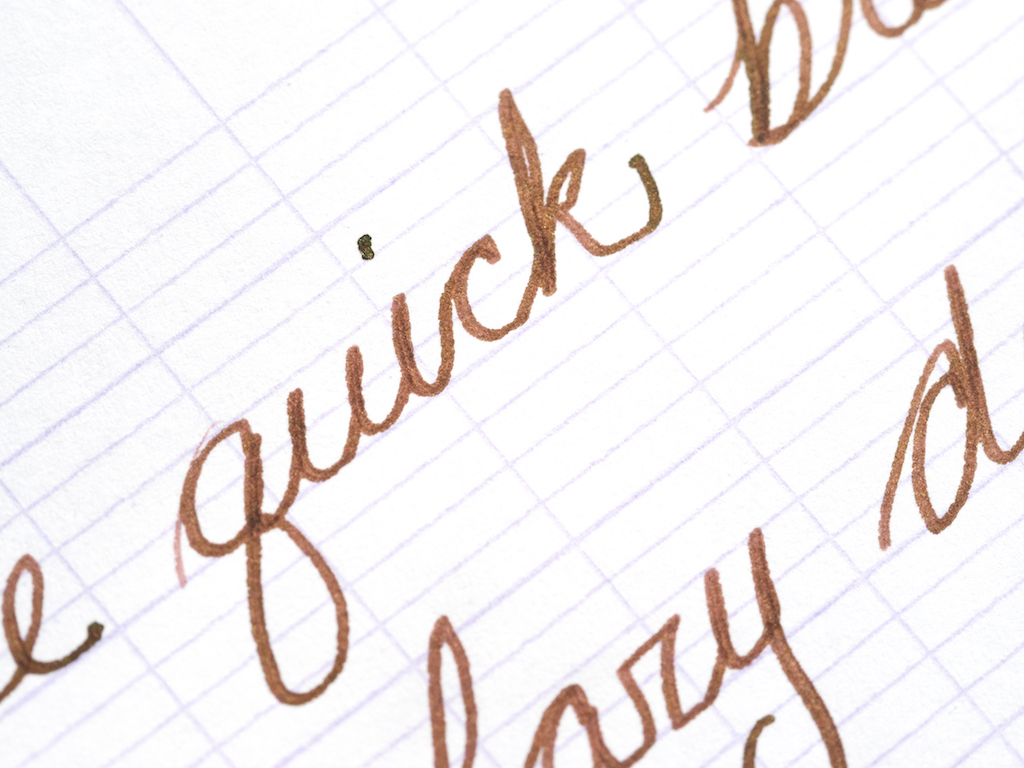(Susan M. Pigott is a fountain pen collector, pen and paperholic, photographer, and professor. You can find more from Susan on her blog Scribalishess.)
The Franklin-Christoph Model 46 is a new design based on the smaller Model 45 but with a #6 size nib. It’s a sleek design with smooth lines tapering to flat finials. Uncapped, the barrel drops gently to a large, curved grip. Even though there’s a distinct edge between the barrel and grip, it’s not sharp and it doesn’t interfere with writing.
The cap is clipless and is a bit shorter than other FC caps. I like this design choice because it suits the pen’s simple aesthetic and shows off the beautiful acrylic. Etched near the base of the cap is “Franklin-Christoph 46,” but the etching is so light you can barely see it except in bright sunlight.
The top finial is etched with the FC logo.
Model 46 currently comes in three colors: black, Autumn Oak, and Winter Pine (at the time of this review Winter Pine appears to be out of stock). Although I initially thought about buying Winter Pine, I decided on Autumn Oak. It’s a beautiful reddish-brown acrylic with flecks of gold and darker brown. The pen shimmers in sunlight and has depth reminiscent of celluloid.
The pen is a cartridge/converter filler and comes standard with a Franklin-Christoph converter. As with most FC models, you can turn the pen into an eye-dropper by rubbing a little silicone grease along the threads. After a few disastrous “middle-age” moments when I unscrewed an eye-droppered Franklin-Christoph, spilling ink everywhere, I just use the converter. Pens like the Opus 88 that have built in rubber O-rings are much easier to use as eye-droppers in my opinion (it also helps if the pen happens to be a demonstrator). Regardless, the FC converter holds a good amount of ink and works really well.
I chose a medium steel nib with a Masuyama stub grind for this pen. I’ve found that Franklin-Christoph’s steel nibs are every bit as good as their gold ones, especially when you get a Masuyama grind. The tines on this stub are perfectly aligned and the nib is decorated with beautiful scrollwork and a tasteful FC logo.
I inked the pen with Diamine Autumn Oak, because, duh! I mean, if you have a pen that is called “Autumn Oak” why wouldn’t you ink it with Diamine Autumn Oak? I wrote with the Diamine ink for several days and was dissatisfied with how dry the pen wrote. I feared that perhaps the nib and feed were ink-stingy.
I decided to switch inks to see if the pen wrote better. I chose Kyo-Iro Higashiyama Moonlight, and it made a world of difference. The nib writes wet and smooth with this ink.
The Franklin-Christoph Model 46 is a medium/small-sized pen, measuring 5.25 inches/133.35mm capped, 6.65 inches/168.91mm posted, and 4.95 inches/125.73mm unposted. It is the smallest member of my FC collection (I don’t own any pocket models).
L to R: FC Model 65, 03, 20, and 46
I am quite pleased with the Model 46. It has a distinct shape and style that sets it apart from my other FC pens. It exudes typical Franklin-Christoph quality, and the color is exquisite.
You can purchase a Model 46 from Franklin-Christoph with a regular steel nib for $150 (music nibs cost $10 more). With a SIG nib, the pen costs $165, and with a Masuyama nib, the cost is $175. This model with a gold nib costs $240.
(I paid for the Franklin-Christoph Model 46 with my own funds.)
Enjoy reading The Pen Addict? Then consider becoming a member to receive additional weekly content, giveaways, and discounts in The Pen Addict shop. Plus, you support me and the site directly, for which I am very grateful.
Membership starts at just $5/month, with a discounted annual option available. To find out more about membership click here and join us!













































